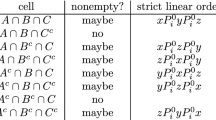Abstract.
In this paper, a new model of multidimensional coalition formation in politics is presented. The model provides an opportunity to analyze a number of different kinds of issues at the same time. A policy space consists of a finite number of independent sub-spaces (policy spaces on certain issues), which can be multidimensional. Any policy sub-space on a certain sub-issue can be either a Euclidean space or (in principle) any other type of set. So, it is possible to include issues which cannot be represented by a Euclidean space or a fixed sum. A government is defined as a pair consisting of a majority coalition and a policy supported by this coalition. The majority coalition may be not minimal winning. Each party is allowed to give one qualification to a policy on a certain issue and to a majority coalition: desirable of a certain degree, acceptable, or unacceptable. By representing party preferences the way we do, we can include both rent-seeking and idealistic motivations in one consistent model. We define the value of a policy/coalition/government to a party, and the notions of a feasible and stable policy/coalition/government. The model uses party preferences in order to predict government policy. Necessary and sufficient conditions for the existence and uniqueness of a stable government are investigated. Moreover, some alternative definitions of a ‘stable’ government are introduced, and relations between these definitions and the chosen definition of a stable government are established.
Similar content being viewed by others
Author information
Authors and Affiliations
Corresponding author
Additional information
For Agnieszka Rusinowska the research for this paper was done during a stay as a Marie Curie fellow at Tilburg University, Department of Philosophy.
Rights and permissions
About this article
Cite this article
Rusinowska, A., Swart, H. & Rijt, JW. A new model of coalition formation. Soc Choice Welfare 24, 129–154 (2005). https://doi.org/10.1007/s00355-003-0295-x
Received:
Accepted:
Issue Date:
DOI: https://doi.org/10.1007/s00355-003-0295-x




